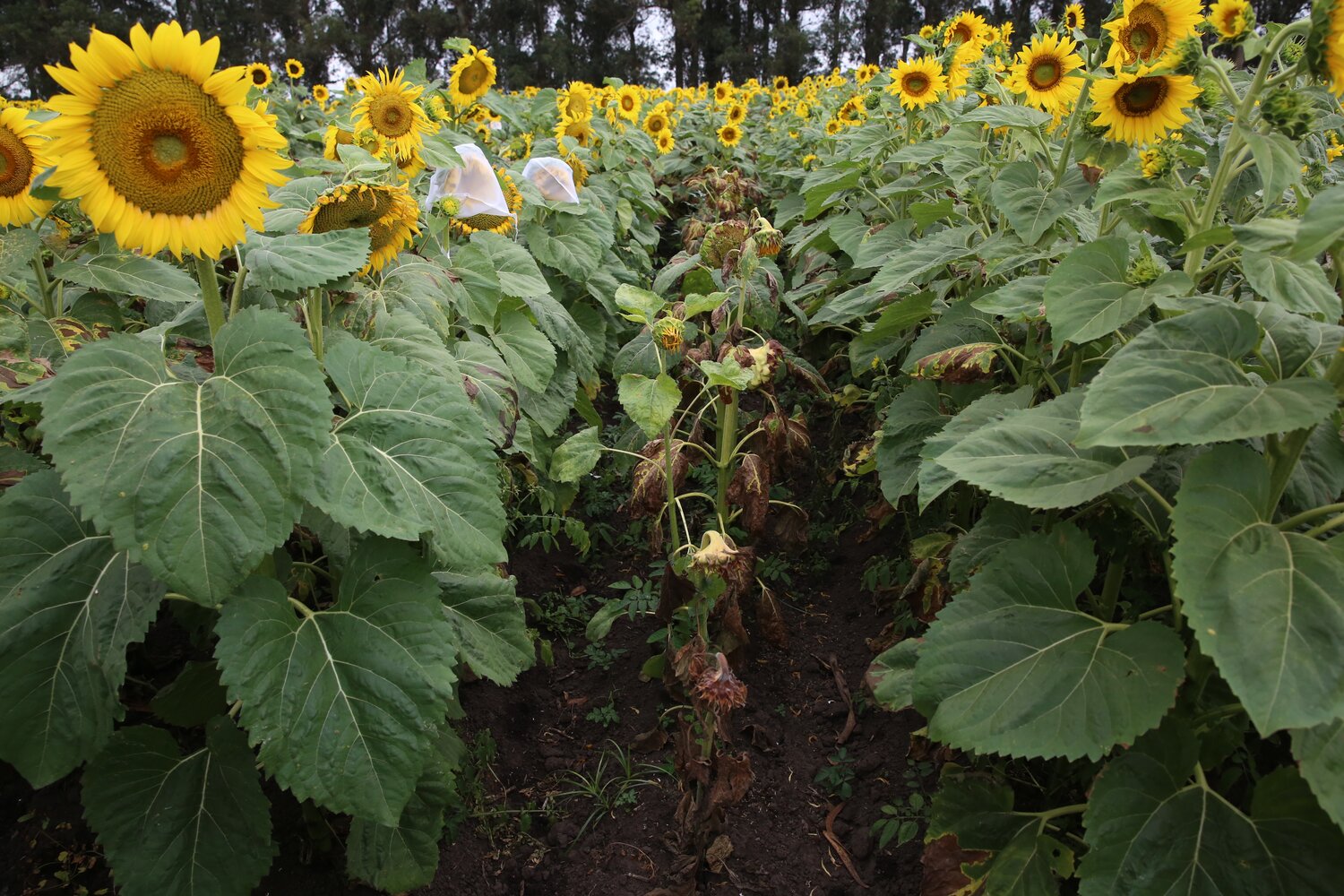Sunflower
Why sunflower?
Over the last 50 years, sunflower (Helianthus annuus L.) has become an increasingly important source of calories in global diets. The crop is mainly cultivated in sub-tropical and tropical regions and its annual global production value is around USD 18 billion.
Increasing the oil content of sunflower varieties and hybrids continues to be one of the main breeding targets. However, new objectives are arising because of environmental challenges and changes in consumer habits. These include maintaining good yields under dry conditions, enhancing oil quality and increasing the protein content of sunflower meal.
What we achieved
Pre-breeding and evaluation
- Sunflower pre-breeding project focused on exploiting wild Helianthus species to develop more environmentally resilient sunflower varieties, particularly suited to cultivation in arid areas.
- 28 sunflower wild relatives were crossed with an elite domesticated sunflower, resulting in 400 hybrid offspring.
- Traits identified included early flowering—an important trait for climate-change adaptation—and large head diameter—a key determinant of yield.
- Promising pre-bred lines were test-crossed with in-bred lines to produce F1 hybrids.
- Field trials in Argentina, Uganda, India and Europe identified promising sunflower germplasm exhibiting tolerance of heat, drought, low nutrient soil and biotic stresses as well as high oil content.
- 360 pre-bred lines were stabilized, multiplied and distributed to sunflower breeding programs around the world.
- Promising ILs have been conserved in the North Central Regional Plant Introduction Station, Ames, Iowa, USA, for sharing with global users through SMTA.

Project partners
Pre-breeding and evaluation
Lead Institute: University of British Colombia, Vancouver, BC, Canada
Partners:
- Instituto Nacional de Tecnología Agropecuaria, Buenos Aires, Argentina
- Indian Institute of Oilseeds Research, Hyderabad, India
- MIGAL – Galilee Research Institute, Kiryat Shmona, Israel
- National Agricultural Research Organization, Entebbe, Uganda
- National Semi-Arid Resources Research Institute, Soroti, Uganda
- North Central Regional Plant Introduction Station, Ames, Iowa, USA
Sunflower key collections, materials and data
Sunflower collections
- The largest Helianthus collection is conserved by the USDA-ARS National Plant Germplasm System.
- The Genesys PGR database also includes information about sunflower accessions in genebanks worldwide
Pre-breeding materials
- All pre-breeding materials developed by the sunflower pre-breeding project are maintained at the North Central Regional Plant Introduction Station, Ames, Iowa, USA.
Data
- All data from the CWR sunflower pre-breeding and evaluation projects are available in the Germinate sunflower database
Sunflower stories
Crop Trust stories
-
A sunflower story. https://www.croptrust.org/blog/a-sunflower-story/. Published 11 June 2020.
-
Threatened Wild Sunflowers. https://www.croptrust.org/news-events/news/threatened-wild-sunflowers/. 2 December 2014.
Relevant publications
- Sosa, C.C, Kantar, M.B., Khoury, C.K., Castañeda-Álvarez, N.P., Kane, N., Marek, L.F., Seiler, G.J., Achicanoy, H., Bernau, V., Rieseberg, L. 2014. Integrating ecogeographic, bioclimatic and phylogenetic analyses for the wild relatives of sunflower (Helianthus annuus L.). Poster. Grand Challenges, Great Solutions. ASA, CSSA, & SSSA International Annual Meeting, November 2–5, 2014, Long Beach, California, USA. https://scisoc.confex.com/scisoc/2014am/webprogram/Paper87972.html (accessed 28 October 2021).
- Baute, G.J. 2015. Genomics of sunflower improvement: From wild relatives to a global oil seed. PhD dissertation. University of British Colombia, Canada.
- Baute, G.J., Kane, N.C., Grassa, C., Lai, Z., Rieseberg, L.H. 2015. Genome scans reveal candidate domestication and improvement genes in cultivated sunflower, as well as post-domestication introgression with wild relatives. New Phytologist 206: 830−838.
- Kantar, M.B., Sosa, C.C., Khoury, C.K., Castañeda-Álvarez, N.P., Achicanoy, H.A., Bernau, V., Kane, N.C., Marek, L., Seiler, G., Rieseberg, L.H. 2015. Ecogeography and utility to plant breeding of the crop wild relatives of sunflower (Helianthus annuus L.). Frontiers in Plant Science 6: 841. https://doi.org/10.3389/fpls.2015.00841
- Baute, G.J., Owens, G.L., Bock, D.G., Rieseberg, L.H. 2016. Genome-wide genotyping-by-sequencing data provide a high-resolution view of wild Helianthus diversity, genetic structure, and interspecies gene flow. American Journal of Botany 103(12): 2170–2177.
- Boateng, S.K., Aboagye, L.M., Egbadzor, K.F., Darko, R.K., Ameka, G.K., Ekpe, P., Kanton, R., Dogbe, W., Saaka-Buah, S. 2019. Collecting of crop wild relatives and minor crops in Ghana. Research in Agricultural & Veterinary Sciences 3(2): 89–95.
- Terzic, S., Boniface, M., Marek, L., Alvarez, D., Baumann, K., Gavrilova, V., Joita-Pacureanu, M., Sujatha, M., Valcova, D., Velasco, L., Hulke, B.S., Jocic, S., Langlade, N., Munos, S., Rieseberg, L., Seiler, G.J., Vear, F. 2020. Gene banks for wild and cultivated sunflower genetic resources. Oilseeds and fats, crops and lipids 27(9): 1–14.

